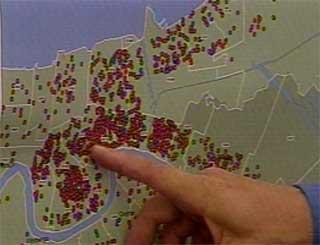Untitled Document
Part of the tragedy of Hurricane Katrina is measured in the number
of people killed by the storm. Thousands of people are still missing, and the
agencies searching for them are not sure how high the death count will go.
Two months ago, Sally Hoy, a hurricane evacuee from Kenner, began working for
FEMA.
Hoy is one of dozens of people working at the Find Family National Call Center,
the group that's trying to locate all of Hurricane Katrina's missing persons.
Hoy is surprised that two months after the storm, she's still getting numerous
first-time callers.
“They're a little more frantic. They feel like they've exhausted every
avenue and they just don't know what else to do,” Hoy said.
There are the good calls, about relatives that have been found safe. However,
Hoy cannot forget the other calls; like the father looking for his son.
"The first call, Troy, the little 9-year-old boy. He drowned," she
said.
 |
The red dots on this map represents
a missing person in the Greater New Orleans area. |
There is a big map of New Orleans posted at the Call Center. Each red dot on
that map represents a person who has been reported missing to the national call
center. The database here has more than 9,000 names in it. So far, almost 4,000
people, about 40%, have been found alive.
4,783 people are still missing, though.
Medical Examiner Dr. Louis Cataldie said it is almost an overwhelming number.
Cataldie said 534 of the people reported as missing are now counted among Katrina's
dead. He does not want to estimate how many of the 4,783 people still missing
may have died.
“If our statistics hold true it could be as many as 5% to 10% of that
number, which would be several hundred people,” Cataldie said. “But
again, I don't know that; and I really don't want to make that blanket statement."
If callers have not seen a family member since Katrina, they are asked to complete
an eight page questionnaire that asks for identifying features. The staff here
searches the internet for clues, and seeks medical records from dentists and
surgeons.
“I'm very concerned that people might have been lost in the surge. (The
deceased individuals) might have gotten into the river…So I don't think
we'll ever find everybody,” Cataldie said.
In some cases, Cataldie said closure will only come when a family realizes there
will be no closure. And sometimes the only comfort Sally Hoy can offer is telling
a caller that people here will keep looking.

